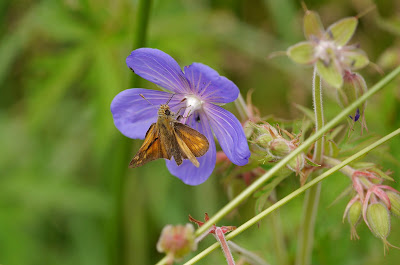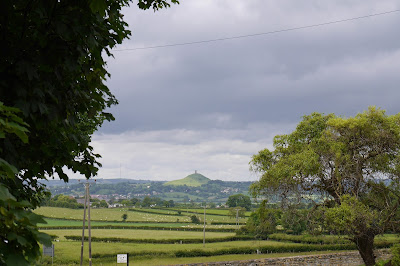View over Salisbury Plain
We resume the Wessex Ridgeway at Stoke Hill overlooking Salisbury Plain from about 220m. We follow the road as far as Coulston Hill and then continue along a track. There are lovely views over the Plain, which in this area seems to contain a number of delightful combes and dry valleys.
We ignore the temptation of the White Horse Trail on our left and continue down a hedged path looking for the next left. There is lots of Meadow Cranes-bill around and this one was host to a Large Skipper.
When we do turn left there is a lovely view through a field gate of the direction of progress: the chimney of the disused cement works just outside Westbury is a landmark for miles around.
We head diagonally downhill and pass Westdow Farm to tunr left again to follow a narrow path next to vast field of Oilseed Rape. The field margin has a solid band of Poppies and some more Meadow Cranes-bill provides a beautiful counterpoint.
Soon after this we head due west, now following the boundary of the MOD firing range - we can hear small arms fire from time to time. In the hedgerow we spot this lovely yellow flower, which we later identified as Common Toadflax.
Now we started to see cows grazing on the MOD ranges. Surely they are not used for target practice?
At length we reached Bratton Camp Fort, an Iron Age hill fort where there were also Neolithic long barrows.
Just round the hillside is the dramatic Westbury White Horse. According to the helpful plaque, "local records suggest that the horse was originally cut in the late 1600s, probably to commemorate the supposed Battle of Ethandun, thought to have taken place at Bratton Camp in AD 878."
The horse had to be re-scoured from time to time to keep it looking good. The last recorded re-scouring was in 1853: a hundred years later it was covered in white-painted concrete. We were frankly shocked by this - we had already detected something rather false about it from the horizontal and vertical lines.
A little further on we admired the slope of Westbury Hill with Westbury itself beyond.
We continued past a massive chalk pit and continued along the Imber Range Perimeter Path. We were still of course skirting the MOD ranges, although the immediate prospect was of a cornfield with a dense population of poppies.
Soon we took a left and headed down a steep hill towards the bottom of a long dry valley.
The climb back up was more gradual and at the top we unaccountably missed the correct path on the left, emerging on the road that leads up from Waminster to the rifle ranges. We weren't sufficiently upset to retrace out steps and simply plodded on down the hill. Just before we reached the car we were surprised to see this old mile post on the left hand side, which had presumably been moved from its original location into this dead-end road.
Conditions: mild, cloudy.
Distance: 9.3 miles. We thought it was going to be about 7 miles. The planners of the walk were duly chastised for their incompetence and have vowed to measure future legs more carefully.
Map: Explorer 143 (Warminster & Trowbridge)
Rating: four stars.




























































